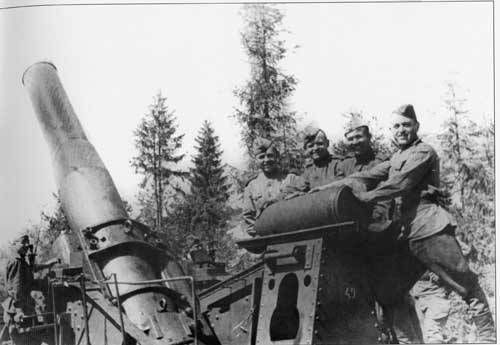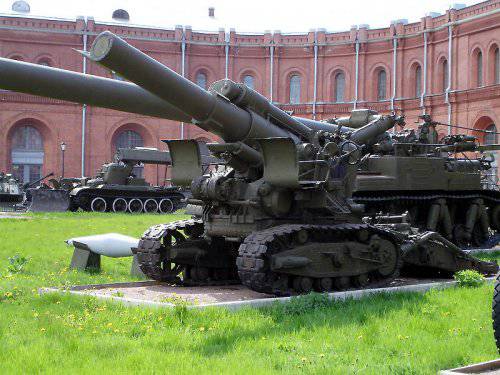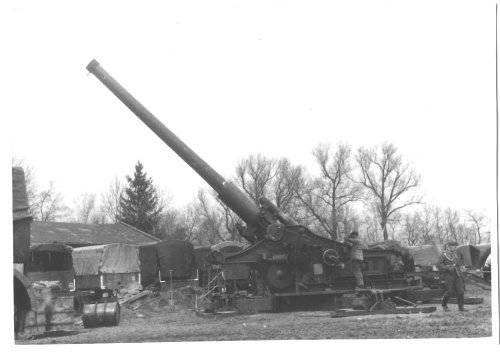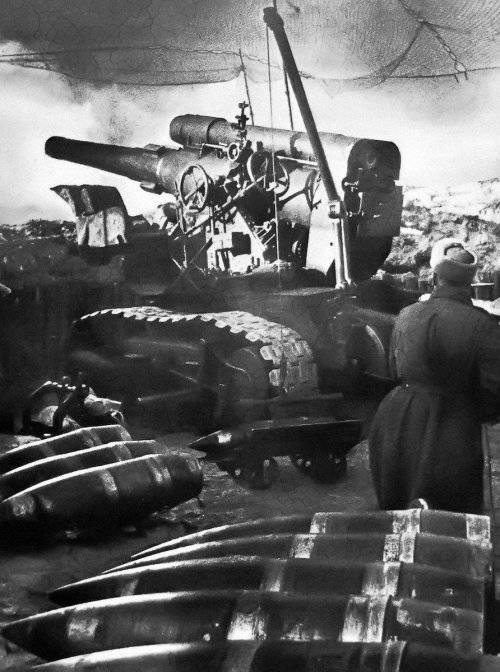The difficult fate of special power tools

On the frames of photographic and film films that captured the battles of the Great Patriotic War, Soviet large-caliber guns and howitzers, which hit the enemy, are very often seen. That is why an ignorant person may get the impression that with what, with what, and with heavy artillery the Red Army had no problems throughout the confrontation with the Wehrmacht. This, however, is far from the case.
I have already repeatedly talked about a number of negative moments in the work of Marshal Mikhail Tukhachevsky. But nothing can be done, it will be necessary to recall once more about one of the “innovations” supported by it, which had very sad consequences for the Red Army.
PARADOXES DEMAND EXPLANATIONS
In my opinion, if Finnish historians were objective in assessing the 1939-1940 Winter War, then a monument to Tukhachevsky would stand in the center of Helsinki with the inscription: “Savior of Finland”. But Suomi is still confident that the “Stalin's empire” could not defeat its north-western neighbor thanks to the genius of the great commander Marshal Carl-Gustav Mannerheim and the exceptional courage of Finnish soldiers.
But how then to explain two phenomena? First, three months before the outbreak of the Winter War, the Red Army defeated Japanese troops on the Khalkhin Gol River. The losses of our and Japanese troops amounted to 6515 and 25 people, respectively. But in the Winter War, the Red Army lost only 000 people killed, and the Finns - 71 people. I note that in the battles on Khalkhin Gol participated Japanese aircraft and tanks one and a half times more than there were in the entire Finnish army in 1939-1940.
Moreover, the training and arming of the Finnish infantry were much worse than the Japanese. There is no need to talk about readiness for self-sacrifice and ability to conduct hand-to-hand combat. Finally, the Finns have not fought with anyone for 20 for years and most of the soldiers have called up from the reserve, while units that had fought in China for many years fought in Khalkhin Gol.
Other numbers are even more paradoxical: in 1939-1940, the Soviet divisions managed to advance from the border to Vyborg in the 2,5 month, and in June the 1944 in the 11 days! That is, our troops in 44-m moved seven times faster. At the same time, during the Winter War, Finland and the USSR fought one on one, and in June 1944, the Red Army fought on the 3000-kilometer front from Barents to the Black Sea. And almost simultaneously with the attack on the Karelian Isthmus, the grand operation "Bagration" began in Belarus.
How to explain these paradoxes? No doubt, the command of the Red Army in the Winter War made a lot of mistakes. But, of course, the main reason for the Red Army failures was the lack of artillery systems capable of coping with Finnish do-millionaires (one million Finnish marks left to build one) on the Mannerheim Line.
The X-NUMX-mm howitzer B-203 — the most powerful Soviet artillery system adopted at the beginning of the war between the USSR and Finland — could penetrate the wall of such a fort only if two of its shells hit the same point. True, the Red Army also had an 4-mm gun model 305 of the year. The weight of its projectile was 1915 kg versus 377 kg in B-100. However, for completely incomprehensible reasons, the 4 completely combat-ready 30-mm howitzers stood idle during the entire war in the Belarusian Military District.
Why in the USSR in the 20-30-ies did not manage to create a single instrument of special power (OM)? To begin with, by January 1, the first batch of four 1918-mm howitzers with 406 projectile weight, kg, was produced at the Obukhov plant by 883 of the year. Their readiness ranged from 75 to 35 percent.
In the National Economy Archive, I studied the plump volume of the correspondence of the beginning of the 20-s, devoted to one question: to finish howitzers or not. In the end, someone ordered them to be scrapped ...
In the 1931 year, the Directorate issued two tasks: KB-2, where German engineers from Rheinmetall worked, to design an 305-mm howitzer on a conventional carriage, and to the Bolshevik plant - triplex (400-mm mortars, 305-mm howitzers and Collapsible type 203-mm guns carried on tracked vehicles). In addition, the engineer of the Bolshevik plant, Chernyavsky, on his own initiative, prepared a project for triplex (400-mm mortar, 305-mm howitzer and 203-mm gun on a conventional gun carriage). In the 1932 year, the Department of Management reviewed all the projects and at the Plenary Session of the AU a resolution was adopted “to approve the project of the 400 / 305 / 203-mm Bolshevik combined system for further development and production of a prototype, and two other projects of the KB-2 and the engineer Chernyavsky to reject” .
Needless to say, if in 1931-1932, full-scale work had begun on the project of Art-management or Chernyavsky, by the 1939, the Red Army would have received several dozen special-power implements. The new 305-mm howitzers and 400-mm mortars for the week would have smashed Finnish millionaires into smithereens, the outcome of the Winter War would be completely different both militarily and politically.
INCOMPETENCE PLUS FALSIFICATION
However, due to his incompetence, Tukhachevsky and Co. completely thwarted all plans to create special-power artillery. At first, these figures demanded that the new guns be fired with projectiles, that is, polygonal, rifled or sub-caliber. Dozens of the most exotic ammunition of all three types of caliber from 203 to 368 mm were tested.
It is easy to argue: the development of science and technology is impossible without errors and delusions. Holy truth! But most of these mistakes and delusions are revealed at the stage of preliminary design, at various technical meetings and councils. However, M. N. Tukhachevsky, deputy people's secretary of armaments (education - infantry school), heavy industry deputy people's secretary and I. P. Pavlunovsky, head of the Main Mobilization Directorate (three classes of parochial school), technical commissar S. Ordzhonikidze (underequired medical assistant) patronized technical adventurers such as Kurchevsky and Bekauri.
If at the councils and meetings honest specialists pointed out the unreality and absurdity of the projects, they were immediately labeled “the enemy of the people”. The test results of prototypes of weapons were falsified, often tests were not carried out at all. So, no less than 20 of Kurchevsky’s dynamo-active cannon samples were launched into the series without carrying out a complete set of tests - factory, field and military.
A typical example: all types of off-fire projectiles that were continuously tested in the USSR from 1920 to 1938 a year passed tests on the Volkov field near Petersburg as early as 1865-1875. I personally read hundreds of reports of such trials as the XIX and XX centuries. And if we discard fraud, the result is completely identical. Why was it necessary to spend hundreds of millions of people's rubles without eliminating in advance a single incurable disease of polygonal, subcaliber, rifled, and other antifouling shells?
By the way, the sabot projectiles were intended for ultra-long range shooting, and nobody even thought of anti-tank sabotage shells until the Germans at the end of 1941 had applied them at the front. And one more interesting fact: first, the 1920-1938 and 1865-1875 tests Identity was discovered not by me, but by one smart gunner who sent a detailed report on these striking coincidences to the People's Commissar for Defense, but a copy to the NKVD.
In 1934, Tukhachevsky and Co. demanded that all new tools of special power be mounted on one self-propelled gun. Shooting also had to be done from him. The very same self-propelled device existed only in the inflamed heads of the designers.
At the conference of the Department of Management in December 1934, the projects of the 203-mm cannon and the 305-mm howitzer on a self-propelled machine were considered. Two independent projects of the latter were developed by the Bolshevik plant and the Pilot Plant. Kirov.
In the end, it turned out that the weight of the system reached 106 tons, and the length exceeded 12 meters. Dimensions did not allow to transport self-propelled by rail, the vast majority of bridges did not withstand its mass. If he were stuck off the road, there would be nothing to pull him out ...
It was only after the removal of Tukhachevsky’s work on the creation of weapons of OM that they were in full swing, and in order to frighten bureaucrats and hack-workers, they were given the name “Stalin’s Order”.
In the summer of 1937, a commission of prominent Soviet gunners visited the Skoda plant in Czechoslovakia. There she presented samples of 210-mm guns and 305-mm howitzers. The barrel of the gun was lined, and howitzers - bonded. The gates of both systems are wedge horizontal, loading is separate-sleeve. I will not restrain myself from the author's remark: on the report of the commission, some idiot from the Armed Management Department stressed “separate-case loading” and wrote boldly: “This is a minus - you need a cap”.
The fact is that all German artillery systems, including special power, even the Dora 800-mm cannon, had cartridge loading.
Because of these rags, the production of Soviet counterparts - X-NUMX-mm cannon Br-210 and X-NUMX-mm howitzer Br-17 lasted almost a year. The wedge gates had to be replaced with piston ones, etc. I note that if the cards gave some cheap savings, then the OM tools were obviously piecewise - well, 305, well, 18 units and the money spent on reworking tools did not pay off with savings in the production of cards .
At the end of 1939 - 1940, the design of purely domestic systems began: 450-mm howitzers Br-23 and 500-mm howitzers with the weight of 1060-1500 shells. Both systems were collapsible: vehicles weighing 20-26 t were transported behind tractors at speeds of 25-30 km / h.

FOR YEAR 1941
But alas war wait did not want to. By the beginning of the Great Patriotic War, the special artillery of the RVGK consisted of the 281 th howitzer artillery regiment of the OM (30 305-mm howitzer of the model 1915 of the year) deployed in Orlovskiy VO, 15 of separate divisions and two separate batteries (305-mm of gauze ki-leashes). mortars), as well as one (280-y) heavy cannon artillery regiment (524 24-mm cannon Br-152), 2-i and 1-i separate heavy gun batteries (two 6-mm cannon Br-152). There was at the disposal of RVGK and artillery of high power - 2 regiment, armed with 33 792-mm B-203 howitzers.
On 22 June 1941 of the Year, the Red Army had 25 280-mm Schneider mortars of model 1915 of the year and 47 280-mm Br-5 mortars. 280-mm 48 mortars were in service with eight separate artillery battalions of special power. Another 24 mortars and four 305-mm howitzers of the 1915 model of the year were in warehouses, factories and landfills.
It should be noted that the projectiles for 280-mm Schneider mortars and Br-5 were the same, and the charges were different. The shells were only old-fashioned, that is, of short length. By June 1941, there were about 7 thousands of 280-mm projectiles and 7,5 thousands of 305-mm projectiles for howitzers of the 1915 model of the year.
By June 1941, almost all the combat-ready parts of artillery of large and special power were concentrated in our western districts. There were a total of 517 203-mm B-4 howitzers, 17 280-mm Schneider mortars and 39 280-mm B-5 XNUMX mm in these parts.
Interestingly, 305-mm howitzers of the 1915 model of the year were also available in the Navy. They were armed with a four-gun battery number 911 near Vladivostok. For her, the fleet had 1788 high-explosive 305-mm howitzer shells.
It is impossible not to mention such a curious fact. In the 20-30-ies, the army command carried out experienced firing of 305-mm howitzers of the 1915 model of the year with 305-mm ship cannons. As a result, the Shells firing tables for the 1907 model of the year and the 1911 model of the year from the 305-mm howitzer were created. A special reduced charge was selected for it: 1907 kg for the 28,46 model projectile, and 1911 kg of gunpowder for the 24,3 model projectile.
LIVING MYTH
The author does not accidentally give boring data on shells. Unfortunately, in the domestic militaryhistorical literature has long spoken about a shortage of ammunition both in the Red Army and in the USSR Navy. In fact, during the whole war, the fleet did not shoot a third of the shells from 130 mm to 406 mm caliber from the total resource, and even in the artillery of the OM there was always an excess of ammunition. Another thing is that they were not delivered on time to the units due to the sloppiness of individual military leaders.
And let's say the truth - we had an excess of incompetent generals. Thus, in the Finnish war, orders were given to lead along the roads "disturbing fire" from Schneider's 280-mm mortars, and to fire into the Great Patriotic War from long-range guns: "Firing in the direction of the enemy until the projectiles are fully expended." And this is a quotation not from Suvorov-Rezun, but from top secret documents.
The volume of the article does not allow us to talk about the lack of artillery tractors and their poor technical condition. As a result, it was precisely due to the lack of vehicles and only in rare cases due to the impact of the enemy during the summer-autumn campaign of the 1941, was 75 203-mm and nine 280-mm howitzers lost. In this regard, in August 1941-th decision is made to send all weapons OM to the deep rear. The production of special-power weapons was practically ceased, and the ammunition for them was significantly reduced.
UPDATES
Information on the availability and release of tanks, airplanes and field guns was no longer a secret even in Brezhnev times, but data on the OM artillery has not yet been published. Therefore, I would venture to tire the reader with a table.
In August, the 1944, as part of the RVGK artillery, two artillery divisions of special power were formed. Each of them was armed with four 211-mm trophy mortars (21 cm Mrs.18). Unlike our 203-mm howitzers, they had not a crawler, but a wheel drive and were much more mobile. However, the best estimate of 21-cm mortars is that our generals attributed it to special power systems, and B-4 to high power systems. In addition, Mrs.18 in the combat position was much lighter than the B-4.
In December, 1944 of the year on the basis of four separate divisions of 152-mm cannons Br-2 and four separate batteries of 210-mm cannons Br-17 were formed by three separate regiments of special power (18-th Guards, 1-th and 2-th). Each of them consisted of three two-gun batteries, Br-2 and one two-gun battery, 210-mm cannons. By the end of 1944, these regiments had gone to the front.
In all, by the 1944, the Red Army had nine X-NUMX-mm cannons, Br-210. They were brought to combat readiness precisely in 17. Shooting tables were first published for them and 1944 thousands of 4,2-mm projectiles were made 210. Curiously, in the first half of 1945, the 210-mm projectiles were not released.
The 305-mm howitzer model 1939 of the year (Br-18) was made only three pieces. They went to the formation of the 233-th separate artillery division of special power, located at the end of the war in Moscow IN. Apparently, these tools were not capable.
In the 1944-1945, the 16 X.UMX X.UMX K.211 captured 38 cannons were included in the special power artillery. (Perhaps this is how our generals called other types of 21-cm German cannons.) These guns fired 120-kg shells at a range of 33,9 km. Weight K.38 in the stowed position - 25,3 tons. The system in the stowed position was transported on three wagons.
The 211-mm K.38 cannons armed four separate OM artillery battalions. In each of them there were four guns. And two OAD OM did not hit the front.
FIGHTING EXAMPLES
The intensity of the use of special power tools in combat conditions is best indicated by the consumption of projectiles. Thus, for the entire war, thousands of shells were sent to the guns of Br-39,4 (including lost) 2. Of these, 8,1 is a thousand in 1943, and 9,9 is thousands in 1944 and 6,4 is thousands in 1945.
The first thousand 280-mm shells were spent in 1943 year, another 4,7 thousand - in 1944-m and 8,45 thousand - in 1945-m.
For the first time since 305, 1917-mm howitzers were used in battles on the Karelian Isthmus in June of 1944. Five OM divisions, armed with 280-mm mortars Br-5 and 305-mm howitzers, were deployed there. In June, about five hundred 1944-mm howitzer shells were spent on the 305 of the year on the Karelian Isthmus.
As a result, it took only 11 days to break through the Mannerheim line and exit to Vyborg. The case was decided by 305 mm howitzers and Baltic gun fire fleet, as well as heavy tanks KV and Churchill.
OM artillery proved extremely effective in the assault of cities turned by fascists into a fortress — Berlin, Poznan. Particularly distinguished our super cannons in the capture of Koenigsberg, who in World War I was the most powerful fortress of the German Empire.
I note that the fortifications of the capital of East Prussia turned out to be so powerful that it was not always possible to penetrate even 280-mm and 305-mm shells. Thus, the OM division of Lieutenant Colonel S. S. Maltsev (six 280-mm mortars Br-5) fired at fort number V. It hit 73 280-mm concrete-shell, but there were only two holes. Nevertheless, by 12 hours of the day 6 April, the fort had returned fire.
The action of X-NUMX-mm howitzers B-203 and 4-mm A-122 cannons on the forts turned out to be ineffective. Thus, 19 120-mm shells and 203 240-mm shells were fired at Fort No. IV. The result is potholes in the brick and concrete walls.
For more than 24 hours, the 329 Artillery Division OM (six 305-mm howitzers) was firing at Fort No. VIII. 78 hits recorded. However, through holes were only five. At the same time, only the right reinforcement caponier was completely destroyed.
The facts from the reports of the capture of Königsberg may raise doubts in someone about the effectiveness of the Soviet OM artillery. But here it is worth recalling that the same German artillery in 1941-1943 years showed similar results.
So, for the entire siege of Leningrad, the 305-mm tower installations of the fort "Krasnaya Gorka" never failed, although the Germans fired hundreds of heavy projectiles on them. In Sevastopol, the tower installations of batteries No. 30 and No. 35 for eight months withstood the fire of German guns of all calibers and the blows of the Luftwaffe. The Germans managed to destroy the towers with the help of two-ton shells 615-mm mortars.
Needless to say, the very first shells of Soviet 450-500-mm howitzers would have destroyed the Konigsberg forts. But alas, as already mentioned, all these howitzers remained in the project or in prototypes. Nevertheless, the OM’s artillery made a huge contribution to the capture of Koenigsberg and saved the lives of thousands of Soviet soldiers.
In the course of the Berlin operation at the breakthrough sites, again, weapons of a large and special power of the RVGK were successfully used. So, for example, in the 8-th Guards Army of the 1 of the Belarusian Front there was an 1-th OM cannon regiment (two 210-mm cannon Br-17 and six 152-mm cannon Br-5), 34-OAD OM (six 280-mm mortars Br-5) and 322-th OAD OM (six 305-mm howitzers).
The Second World War confirmed that howitzers and mortars of special power - the most effective weapon during the storming of reinforced concrete fortifications, as well as in street battles in cities with large stone houses. Even aircraft could not compete with them, at least until the use of guided bombs.



Information